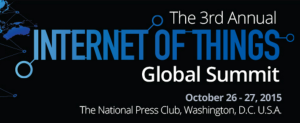Yesterday’s NYT had the most thoughtful piece I’ve seen about the long-term implications of the FBI’s attempts to get Apple to add a “backdoor” to the iPhone that would allow the agency to examine the data on the phone of terrorist Syed Farook, who, along with his wife, killed 14 late last year.
The growth and potential impact of the Internet of Things on our lives will only make the significance of this landmark case greater over time, and I stand totally with Apple CEO Tim Cook (“this is not a poll, this is about the future”) on what I think is a decision that every thinking person concerned about the growing role of technology in our lives should support. It’s that important!
First, my standard disclaimer about Apple, i.e., that I work part-time at the Apple Store, but know as much as you do about Apple’s decision-making process and have zero impact on it. Now for a couple of other personal considerations to establish my bona fides on the issue:
- I’m pretty certain I was the first person to suggest (via a Boston Globe op-ed two weeks [“Fight Terrorism With Palm Pilots”] or so after 9/11 that the early mobiles could be used to help the public report possible threats and/or respond to terrorism. Several years later I wrote the first primitive app for first-generation PDAs (“Terrorism Survival Planner”) on the subject, and did consulting work for both the Department of Homeland Security and the CTIA on how first-generation smart phones could be used as part of terrorism prevention.
I take this possibility seriously, support creative use of smartphone in terrorism preparation and response, and also realize that cellphone contents can not only help document cases, but also possibly prevent future ones. - As I’ve said before, I used to do corporate crisis management consulting, so I understand how fear can cloud people’s judgment on issues of this sort.
- I’m also proud to come from a 300+ year line of attorneys, most particularly my younger brother, Charles, who had an award-winning career defending indigent clients on appeal, including many where it might have been tempting to have abridged their civil rights because of the heinous nature of the crimes they were accused of committing.
I like to think of myself as a civil libertarian as well, because I’ve seen too many instances where civil liberties were abridged for one extremely unlikeable person, only to have that serve as precedent for future cases where good people were swallowed up and unjustly convicted (yea, Innocence Project!).
And this case comes right on the heels of my recent blog posts about how federal authorities such as James Clapper were already taking far too much (IMHO) interest in obtaining a treasure trove of data from our home IoT devices.
All in all, there’s a very real threat that the general public may become rightly paranoid about the potential threats to their privacy from cell phones and IoT devices and toss ’em in the trash can.
That’s all by way of introduction to Farhad Manjoo’s excellent piece in the Times exploring the subtleties of Apple’s decision to fight the feds (see Tim Cook’s ABC interview here) — with plenty of emphasis on how it would affect confidence in the IoT.
As his lede said:
“To understand what’s at stake in the battle between Apple and the F.B.I. over cracking open a terrorist’s smartphone, it helps to be able to predict the future of the tech industry.”
Manjoo went on to detail the path we’re heading down, in which the IoT will play an increasingly prominent place (hmm: in my ardor for Amazon’s Echo, I’d totally ignored the potential for the feds or bad guys or both [sometimes in our history, they’ve sadly been one and the same, for more details, consider one J. Edgar Hoover..] to use that unobtrusive little cylinder on your kitchen counter to easily monitor everything you and your family say! Chilling, non?).
Read and weep:
“Consider all the technologies we think we want — not just better and more useful phones, but cars that drive themselves, smart assistants you control through voice or household appliances that you can monitor and manage from afar. Many will have cameras, microphones and sensors gathering more data, and an ever more sophisticated mining effort to make sense of it all. Everyday devices will be recording and analyzing your every utterance and action.
“This gets to why tech companies, not to mention we users, should fear the repercussions of the Apple case. Law enforcement officials and their supporters argue that when armed with a valid court order, the cops should never be locked out of any device that might be important in an investigation.
“But if Apple is forced to break its own security to get inside a phone that it had promised users was inviolable, the supposed safety of the always-watching future starts to fall apart. If every device can monitor you, and if they can all be tapped by law enforcement officials under court order, can anyone ever have a truly private conversation? Are we building a world in which there’s no longer any room for keeping secrets?” (my emphasis)
Ominously, he went on to quote Prof. Neil Richards, an expert prognosticator on the growing threats to privacy from our growing dependence on personal technology:
“’This case can’t be a one-time deal,’ said Neil Richards, a professor at the Washington University School of Law. ‘This is about the future.’
“Mr. Richards is the author of “Intellectual Privacy,” a book that examines the dangers of a society in which technology and law conspire to eliminate the possibility of thinking without fear of surveillance. He argues that intellectual creativity depends on a baseline measure of privacy, and that privacy is being eroded by cameras, microphones and sensors we’re all voluntarily surrounding ourselves with.
“’If we care about free expression, we have to care about the ways in which we come up with interesting things to say in the first place,’ he said. ‘And if we are always monitored, always watched, always recorded, we’re going to be much more reluctant to experiment with controversial, eccentric, weird, ‘deviant’ ideas — and most of the ideas that we care about deeply were once highly controversial.’”
Manjoo also points out that laws on these issues often lag years behind technology (see what Rep. Ted Lieu, one of only four Representatives to have studied computer science, said about the issue).
Chris Sogogian, the ACLU’s chief technologist, brings it home squarely to the IoT’s future:
“’What we really need for the Internet of Things to not turn into the Internet of Surveillance is a clear ruling that says that the companies we’re inviting into our homes and bedrooms cannot be conscripted to turn their products into roving bugs for the F.B.I.,’ he said.”
Indeed, and, as I’ve said before, it behooves IoT companies to both build in tough privacy and security protections themselves, and become actively involved in coalitions such as the Online Trust Alliance.
The whole article is great, and I strongly urge you to read the whole thing.
IMHO, this case is a call to arms for the IoT industry, and the hottest places in hell will be reserved for those who continue to sit at their laptops planning their latest cool app and/or device, without becoming involved in collaborative efforts to find detailed solutions that preserve our personal privacy and civil liberties on one hand, and, on the other, realize there’s a legitimate need to use the same technology to catch bad guys and protect us. It will take years, and it will require really, really hard work.
Oh, and it will also take the wisdom of Solomon for the courts to judge these issues. Sorry to be a partisan, but please feel free to let Sen. McConnell know how you feel about his unilateral decision to keep the Supreme Court deadlocked on this and other crucial issues for well over a year. Yes, even King Solomon couldn’t get past the Senate this year…




